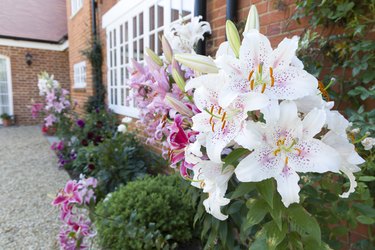
Beloved for their delicate, trumpet-shaped petals, lilies (Lilium, USDA plant hardiness zones 4 through 9) are perennial plants, meaning they are flowers that come back every year. No different from the life cycle of flowering plants, understanding the Lilium life cycle is an asset to growing lilies.
Essential Lily Overview
Video of the Day
There are 80 to 100 flower types in the Liliaceae family. However, there is just one "true lily" under the genus Lilium. This means that the varieties thought of as lilies, such as peace lilies, water lilies and lily of the valley, are not true lilies. There are two types most commonly used by gardeners: the Asiatic and Oriental varieties.
Video of the Day
Asiatic lilies can grow from 1 to 6 feet tall and are considered the easiest to grow. Available in various shades from pure white to pinks, yellows, oranges and reds, Asiatic lilies are not very fragrant despite their popularity in floral arrangements. Oriental lilies start to bloom as the Asiatic lilies begin to fade around mid to late summer. They can grow anywhere from 2 to 8 feet tall and are available in white, pink or red shades. Unlike the Asiatic lilies, Oriental lilies have a strong fragrance that intensifies at night.
Life Cycle of Lilies
The life cycle of lilies includes germination, growth, pollination, fertilization and seed dispersal. Throughout a plant's life cycle, plants either reproduce sexually or asexually. All flowering plants, including lilies, undergo a cyclelike sexual reproduction. Germination begins when a seed on the ground is met with warmth and water. Inside a seed is a plant embryo – essentially an immature plant surrounded by nutrients stored in a protective seed coat.
Lily bulbs are considered monocots as opposed to dicots because they possess one cotyledon, which is an embryonic leaflike structure inside the bulbs. This single leaf absorbs the nutrients until the bulb can produce a seedling.
Growth of a Lily
Growth begins once a seedling sprouts from the bulb. Throughout this process, the lily will acquire the ability to produce its food through photosynthesis. This begins as soon as the first leaves emerge. Through photosynthesis, plants can convert energy from sunlight, carbon dioxide and water into sugars, which the plants store in their roots and stem.
Throughout the growth stage, the lily's root system develops further, allowing it to absorb more water and nutrients through the soil. The stem will grow taller and produce more leaves, reaching closer to the sun to absorb more light. Eventually, flower buds will start to form, signifying the beginning of the reproduction stage.
Pollination and Fertilization
Lily pollination and fertilization take place once the flowers bloom. In a lily flower are male and female parts. The stamens – the male parts of the lily – are made of a filament on top of which sits the anthers. Pollen is produced inside the anthers.
Pollination occurs when the pollen from the anthers is carried either by the wind or a pollinator, such as bees and butterflies, to the stigma of another lily. The stigma is the female part of a flower. The pollen is then carried down to the ovule inside the flower. Fertilization occurs when the ovule makes contact with the pollen. The ovule then develops into a seed containing a tiny embryo, which then gets dispersed, and the life cycle goes on.
- Britannica: Lily
- Buckeye Yard & Garden Online: Asiatic vs. Oriental Lilies... Same Plants or Different?
- BBC: What Are the Stages of a Plant's Life Cycle?
- Microscopy U: Lily Seed Embryo
- Avas Flowers: The Stages of the Flower Life Cycle
- American Museum of Natural History: Parts of a Flower
- Science Learning Hub: Flowering Plant Life Cycles